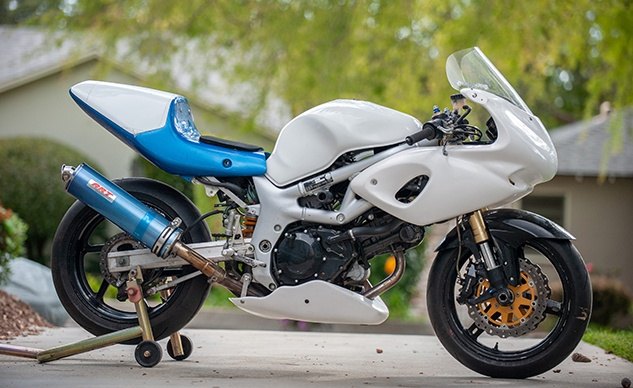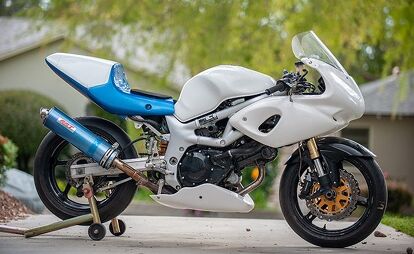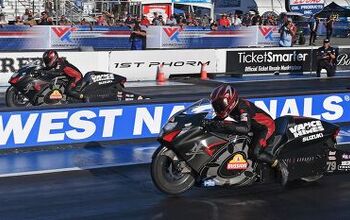Bringing A 20 Year-Old Motorcycle Back To Life

Restoring Trizzle's 2000 Suzuki SV650
I credit my early foundations in motorcycling to my beloved Suzuki SV650. Like with any sport, you need to learn the basics before you can progress to the more advanced stuff, and while my motorcycling career progressed on a number of different motorcycles over the years, my foundation was solidly built on my humble little SV.
In the early days of my moto-journo career, the glitz and glamour of being able to ride other people’s motorcycles persuaded me that I really didn’t have a need for my SV anymore. And so, I let it sit, for 11 years, at my friend’s shop in the Florida panhandle. As a thank you to my friend, I basically handed him the keys to the bike and let him do with it as he pleased. Over that decade-plus, parts were pillaged off the bike to help other SVs continue down the road. Then, eventually, it was forgotten and left to rot. Thank goodness it was indoors, at least.
Fast forward a bit and I’m starting to feel nostalgic. These new bikes are great and all, but I can’t deny how complicated modern motorcycles have become. One of the reasons I bought the SV in the first place is because it’s so simple. I even opted for an early, first-gen SV instead of the later, fuel-injected ones, because it has carburetors (and because I liked the way it looks better). Talk about simple. Frankly, I missed the ‘ol SV. So, I decided it was time it came back home.
If you’ve been reading MO for a while, then you might remember the tale of getting my Suzuki SV650 shipped back to me from Florida. Those years weren’t kind to the poor SV either, as parts got stripped and whatever remained got subjected to the cruel fate that is being stuck in Florida for over a decade.
It’s now been 18 months since I got the bike back in its battered and tattered state. I said at the time I was going to bring the bike back to life in my spare time, and a few of you have even asked about an update. Well, I basically don’t have spare time anymore with a young family at home. So, I sent the bike and a bunch of spare and/or replacement parts I scrounged up to Wrench Motorcycle Service to put back together.
Unfortunately, the shop owner recently decided to go a different direction with the business, closing the service side to focus on other projects. So, the SV is far from done. However, it’s a lot farther along than I ever could have accomplished in this time. And best of all – it runs! Being a track-only bike, and with the world basically shut down due to Coronavirus, I have yet to ride it. But (some of) you wanted an update, and here it is.
Before:
After:
So what’s changed? Starting at the front, the old, rotted tires were replaced with Pirelli’s Supercorsa TD tire – one of my personal favorites. Eagle eyes might notice the front end doesn’t look like a normal SV front. Correct! The complete front end conversion (fork, triples, wheels, calipers) comes courtesy of a 2004 GSX-R600 – the first year it had an inverted fork and radial brake calipers. The conversion itself was incredibly simple, as it’s basically a plug-and-play swap other than exchanging some headstock bearings. The forks are also about 20mm shorter than the stockers, reducing trail slightly, but I don’t remember it being a problem. I never worried about a speedometer either, since the bike was going to live at the track.
Actually, the conversion was done a long time ago, but it’s worth pointing out in the odd chance anyone actually reading this isn’t familiar with the SV. The only change I made was replacing the original warped rotors with these wave discs and swapping the stock master cylinder with a Brembo unit which, I’m ashamed to admit, I don’t remember anything about. Had I to do it over again I probably would have kept the stock forks and upgraded the (crappy) internals and brakes. Many race classes don’t allow fork conversions, meaning this bike is bumped up to different classes where it would be less competitive. It’s kinda strange this rule still exists today since these forks (even if you upgrade the internals) don’t provide that much of an advantage. But young me was vain and liked the bling factor, so here we are.
Before:
After:
The Business End:
There’s a lot packed into the above photo. Beyond the new tire and brake caliper rebuild, a new bikini fairing and belly pan were sourced from Sebimoto in the Czech Republic. These were chosen for a few reasons. First, because I had this exact same bodywork on the bike when it was put into storage all those years ago. Second, I like the minimalist design that closely mimics the stock bodywork instead of other aftermarket fairings that cover the entire side of the motorcycle. Third, and maybe most importantly, it was actually cheaper for me to purchase these fairings and have them shipped from the Czech Republic than order a set of fairings domestically – with a design I didn’t even like.
As anyone who’s installed cheap bodywork can tell you, the price you pay for those fairings may not be monetary, but it comes back to bite you during installation. The nose fairing wasn’t terribly difficult, as both the stock fairing tabs and new bodywork only needed minor persuasion to line up, but since the SV didn’t come with a belly pan originally, custom mounts had to be made. Again, not terribly difficult, as a few strips of metal stock bolted to existing locations works just fine, but it wasn’t until after installation that we looked at the pan and thought it looked pretty low. Then I remembered my original belly pan from a decade ago would severely drag on the ground at even moderate lean angles. The “fix” was to clearance the pan around the front cylinder exhaust header to help install the pan a little higher. We’ll see how much this actually helps the dragging problem.
Windscreen
One of the perks of this job is being able to ride a wide variety of motorcycles. This variety has helped me realize the beauty of a large bubble for the rider to tuck into. And what better to create a huge bubble than… a touring windscreen. A flip through the Zero Gravity catalog discovered this touring screen specifically for SV650s, and a call to their offices revealed they only had one more left in stock. That made the purchase decision pretty easy. Here the water spots help illustrate just how tall the screen rises – the standard screen terminates just above the Zero Gravity sticker.
Gas Tank
In the SV community, finding a gas tank without a dent in it is like finding the holy grail. The thing about SVs of this vintage, however, is they never came in white. In case you’re not picking up what I’m putting down, the tank you see here has had some work done. This tank was found on Ebay with a few dents, but none too bad. It was repaired and repainted anyway. Hellooo Bondo…
Engine
If you look at the before photo at the top of the page you’ll notice there’s a lot of things missing, including the stock airbox and carburetors. Back in the day, I rejetted the stock carbs for a little better performance, and enlarged the stock airbox opening for a little better air flow. I did all that because I couldn’t afford the upgrade I really wanted: flat slide carburetors. Specifically, the Keihin FCR series carbs. Compared to the CV (Constant Velocity) carbs the SV originally came with, the main advantage of the FCR carbs is a direct relation between the throttle and the slide. With CV carbs, turning the throttle opens a valve, which then moves the slide (an oversimplification). FCR’s not only give a direct connection to the engine, they also add a little extra horsepower, but this advantage is primarily on the top end, making them ideal for a track bike. Not so much for a street bike. FCRs also don’t have a choke, so cold starts are a bit more involved.
Typically going for around a thousand bucks a set, I couldn’t justify the cost. If you haven’t noticed by now, I’m cheap. I was perfectly content with grabbing another set of stock carbs until our pal Chris Redpath, proprietor of MotoGP Werks, found this set for a smoking price. Best of all, he said it was coming off another SV650 in California, meaning the jetting should be dialed. It was a deal I couldn’t pass up. The throttle linkages and necessary hardware to install the carbs onto the intake plenum weren’t part of the deal, however, and fabricating some of the parts was beyond my pay grade. This is where Wrench really came in handy, as fabrication is one of the shop’s specialties.
A Domino double-pull throttle linkage was sourced, with the respective throttle cables fitted to each carb. Uni foam pod filters stick out the top and rest under the gas tank (no way I’m brave enough to run without air filters). Other than that, I’m thankful the engine itself was left unharmed. The obvious things like a change of oil, a new oil filter, new coolant hoses, and fresh coolant were done. A fresh battery later and the engine came roaring back to life again!
Exhaust and Subframe
I thought getting an exhaust for the SV would be a simple endeavour, and it was, except for the fact that I needed a full system, complete with headers. Finding a full system for a first-gen SV proved a little harder than I expected. Yet again, Ebay proved invaluable when searching for this stuff (although stupid me hadn’t yet discovered SV Facebook groups yet). I didn’t particularly care for the blue on this ART canister, but it was all I could find. And yes, I know it’s missing an exhaust hanger. Once mounted, the engine sounds loud and throaty, like a healthy V-Twin should.
I didn’t realize it at the time, but the blue hue sorta matched the blue tail section I got for the SV several years ago. During my first go-round with the bike I came across an aluminum subframe someone was selling for dirt cheap because there was a hairline fracture on it. He was even including the tail section, too. So, I snatched it up. I didn’t know about TIG welding at the time, but thought for sure there was someone out there who could fix it. Turns out I was right.
With the tail section removed, you can see how much smaller this aluminum subframe is compared to the steel stocker at the top of the page. Since I’m not carrying a passenger or luggage ever again on this bike, there’s no need for the big, sturdy stock subframe. So this piece saves a lot of unnecessary weight. I never got around to actually weighing the two, but just holding them reveals an obvious difference.
Far From Done
Earlier I mentioned this SV project is far from done, but the important thing at this stage is the fact the bike can fire under its own power! Now there are lots of little things to clean up or improve. The suspension needs rebuilding, the wiring harness will be reduced to its essential wires, I’d like more braking power, and I need to modify the seating position to raise me up on the bike some more. As it is, I feel like I’m sitting on top of the rear tire. From there, I’d be perfectly happy to ride it again! Does it need more power? Sure, but I’m actually happy where it’s at. It’s never been on the dyno, but I’d estimate it’s somewhere in the 70-75 hp range. Other than the FCR carbs and exhaust, it already has a set of camshafts. Short of opening the engine, there’s nothing else left to do. Besides, if I wanted power I would have bought something else.
However, the more I look at the bike, the more dirt and grime I find. Everywhere. It bugs me. Depending on how long we’ll be cooped up at home avoiding the Coronavirus, I might tackle more projects, like giving the bike a deep cleaning, installing a quickshifter, swapping the huge OEM instrument cluster for something more tidy, or even swapping the Honda CBR600F3 rear wheel I have on now (chosen for its 5-inch width vs. the stock SV’s 4.5-inch width, allowing 160-series tires to sit properly on the wheel without pinching) for a 5.5-inch GSX-R wheel and the tire options it provides. Maybe a slipper clutch is in the future, too. The possibilities are endless, which is the beauty of owning a 20 year-old Suzuki. Any mod worth doing has already been done. It’s just a forum click away.
I’ll write an update on this project some day, which will hopefully include actually riding the bike. Just don’t hold your breath.

Troy's been riding motorcycles and writing about them since 2006, getting his start at Rider Magazine. From there, he moved to Sport Rider Magazine before finally landing at Motorcycle.com in 2011. A lifelong gearhead who didn't fully immerse himself in motorcycles until his teenage years, Troy's interests have always been in technology, performance, and going fast. Naturally, racing was the perfect avenue to combine all three. Troy has been racing nearly as long as he's been riding and has competed at the AMA national level. He's also won multiple club races throughout the country, culminating in a Utah Sport Bike Association championship in 2011. He has been invited as a guest instructor for the Yamaha Champions Riding School, and when he's not out riding, he's either wrenching on bikes or watching MotoGP.
More by Troy Siahaan































































Comments
Join the conversation
@troy_siahaan:disqus Nope. Not only are those forks not from a 2006 bike, but 2006 wasn't the first year the GSX-R600/750 (they shared brake and fork components for the K4/K5 models) got USD forks and radial brake calipers. The 2004/K4 model was the first year/model they got inverted forks and radial calipers. Here you can see a bunch of K4 Gixxer 600s with radial calipers and USD forks. Note they all have gold calipers, gold uppers, chrome stanchions, and black lowers. That's how you know the forks are from a K4-K5 GSX-R600/750. Later models have different color combinations, which you can see here.
I can definitely confirm that a GSX-R wheel works really, really well on the bike.
It is a one of kind cool bike. Makes its special. I grew up with 2 strokes. So easy to pull the whole bike apart to repaint frames, etc. Simplicity makes things fun. Carbs are not too bad. Love your article’